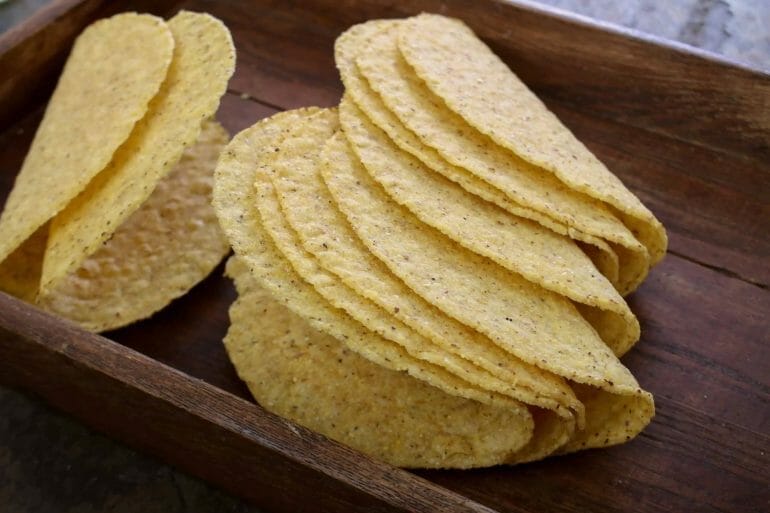Taco shells, like any other food item, can go bad if not stored properly. It is important to check the expiration date and inspect the packaging for any signs of damage before consuming. Taco shells can become stale and lose their crispness over time, causing them to taste unpleasant. To ensure freshness, store taco shells in a cool, dry place, preferably in an airtight container. If you notice any mold, strange odor, or unusual texture, it is best to discard the taco shells to avoid any potential health risks.

Signs of Spoiled Taco Shells: Identifying Bad Shell
When it comes to enjoying a delicious taco, the shell plays a crucial role in adding texture and flavor. However, sometimes taco shells can spoil if they are not stored properly or if they have passed their expiration date. In this section, we will explore the signs that can help you identify a spoiled taco shell, so you can avoid any unpleasant experiences.
1. Visual Changes
One of the easiest ways to determine if a taco shell has gone bad is by examining its appearance. Look for any visual changes such as discoloration, mold growth, or a slimy texture. A fresh taco shell should have a golden or light brown color and should not show any signs of spoilage.
2. Unpleasant Odor
A spoiled taco shell may emit a foul or rancid smell. If you notice any unusual or unpleasant odors coming from the taco shell, it is a clear indication that it is no longer suitable for consumption. Trust your sense of smell and discard any taco shells that have a strong, off-putting odor.
3. Texture Changes
Another sign of a spoiled taco shell is a change in its texture. Fresh taco shells should be crispy and crunchy. If you notice that the shell has become soft, soggy, or chewy, it may be a sign of spoilage. Avoid eating taco shells that have lost their original texture, as they may not taste good and can potentially cause foodborne illnesses.
4. Expiration Date
Always check the expiration date of the taco shell package before consuming them. Taco shells, like any other food product, have a limited shelf life. If the taco shells have passed their expiration date, it is advisable not to use them, as they can become stale or even develop harmful bacteria.
5. Taste Test
If you suspect that a taco shell may be spoiled but are unsure, you can perform a taste test. However, proceed with caution. Take a small bite of the shell and pay attention to the taste. If it tastes off, sour, or has an unpleasant flavor, it is better to discard it to avoid any potential foodborne illness.
6. Packaging Condition
Inspect the packaging of the taco shells before purchasing or using them. Ensure that the package is intact, without any tears or damage. Damaged packaging can allow air or moisture to enter, increasing the chances of spoilage. Opt for taco shells in properly sealed packaging to ensure their freshness.
In summary, it is essential to be able to identify the signs of spoiled taco shells to ensure your safety and enjoyment. Look for visual changes, unpleasant odors, texture changes, and always check the expiration date. If the taco shells exhibit any of these signs, it is best to err on the side of caution and discard them. Remember, when it comes to your health, it’s always better to be safe than sorry.

Proper Storage of Taco Shells: Extending their Freshness
When it comes to enjoying delicious tacos, the freshness of the taco shells plays a vital role in enhancing the overall taste and texture. To ensure that your taco shells stay fresh and crispy for longer periods, proper storage techniques are essential. In this section, we will explore the best practices for storing taco shells and extending their freshness.
1. Choose the Right Packaging
When purchasing taco shells, opt for packages that are sealed and airtight. This helps in preventing moisture and air from entering the packaging and causing the shells to become stale. Look for packaging that has a resealable feature, which allows you to seal the package tightly after each use.
2. Store in a Cool and Dry Place
Taco shells are sensitive to moisture and humidity, which can quickly make them lose their crunchiness. Store your taco shells in a cool and dry place, away from direct sunlight and sources of heat. The pantry or a kitchen cabinet is an ideal location for storage.
3. Use an Airtight Container
If the original packaging of the taco shells is not resealable or if you have opened the package, transfer the shells to an airtight container. This helps to create a barrier against moisture and keeps the shells crisp and fresh. Make sure the container is clean and dry before transferring the shells.
4. Avoid Freezing Taco Shells
While freezing is a common method of preserving food, it is not recommended for taco shells. Freezing can cause the shells to become soggy and lose their texture. Instead, focus on using proper storage techniques to maintain the freshness of the taco shells without resorting to freezing.
5. Do Not Crush or Stack Heavily
Taco shells are delicate and can easily break or crumble if handled roughly. Avoid crushing or stacking them heavily to prevent damage. Store them in a way that they are not under any pressure or weight. You can use a storage container with individual compartments to keep each shell separate and protected.
6. Check for Freshness Before Use
Prior to using taco shells, always check for freshness. Inspect the shells for any signs of mold, discoloration, or a rancid smell. If any of these signs are present, do not use the shells and dispose of them properly. Using stale taco shells can affect the taste and pose a health risk.
7. Purchase in Small Batches
It is advisable to purchase taco shells in small batches to ensure that you can consume them within a reasonable time frame. This helps to avoid storing large quantities for extended periods, which increases the chances of the shells losing their freshness.
8. Properly Seal Opened Packages
If you have opened a package of taco shells and only used a portion, it is crucial to seal the remaining shells properly. Use a bag clip or airtight container to tightly seal the package, preventing air and moisture from entering. This will help to maintain the freshness of the unused shells.
In summary, to extend the freshness of taco shells, choose the right packaging, store them in a cool and dry place, use an airtight container, avoid freezing, handle them delicately, check for freshness before use, purchase in small batches, and properly seal opened packages. By following these storage practices, you can ensure that your taco shells remain fresh, crispy, and ready to be filled with delicious ingredients.

Can You Freeze Taco Shells?
If you find yourself with a surplus of taco shells or just want to plan ahead for future taco nights, you may be wondering if you can freeze taco shells. The good news is, yes, you absolutely can freeze taco shells! Freezing taco shells is a convenient way to extend their shelf life and ensure that you always have shells on hand whenever a taco craving strikes.
Tips for Freezing Taco Shells
Now that you know you can freeze taco shells, let’s dive into some helpful tips to ensure that your frozen taco shells retain their freshness and taste:
- Choose the right packaging: Before freezing taco shells, it’s important to select the right packaging to prevent freezer burn. Individually wrapping each taco shell in plastic wrap or using freezer bags will help maintain their quality.
- Remove excess air: When using freezer bags, make sure to squeeze out any excess air before sealing the bag. This will help prevent the shells from becoming stale or absorbing any unwanted moisture.
- Label and date: Don’t forget to label the packaging with the date of freezing. This will help you keep track of how long the shells have been frozen and ensure you use the oldest ones first.
- Store in a flat position: To prevent the taco shells from breaking or getting crushed, store them in a flat position in the freezer. This will help them maintain their shape and make it easier to stack them neatly.
- Freezing time: Taco shells can be stored in the freezer for up to 3 months without a significant decrease in quality. However, it’s best to consume them within the first month for optimal taste and texture.
Thawing Taco Shells
When it comes time to use your frozen taco shells, here are some simple methods to thaw them:
- Room temperature: The easiest way to thaw taco shells is to let them sit at room temperature for about 30 minutes. This allows them to defrost naturally without any external heat sources.
- Oven method: Preheat your oven to a low temperature (around 250°F or 120°C). Place the frozen taco shells on a baking sheet and warm them in the oven for about 5-7 minutes. Keep a close eye on them to prevent them from becoming too crispy or burnt.
- Microwave method: If you’re in a hurry, you can defrost taco shells in the microwave. Wrap them in a damp paper towel and heat them in 30-second intervals until they become pliable.
Note: It’s important to only thaw the quantity of taco shells you intend to use immediately. Refreezing thawed taco shells is not recommended as it can affect their texture and taste.
In summary, freezing taco shells is a great way to extend their shelf life and ensure you always have them on hand. By following these tips for freezing and thawing taco shells, you can enjoy fresh and delicious tacos whenever you desire without worrying about the shells going to waste.
1. Stuffed Taco Shells
Don’t let your stale taco shells go to waste! One creative way to use them is by making stuffed taco shells. Instead of using the shells for regular tacos, stuff them with delicious ingredients and bake them for a crispy and flavorful treat. Here’s how you can make stuffed taco shells:
- Preheat your oven to 350°F (175°C).
- In a frying pan, heat some oil and sauté onions, garlic, and your choice of vegetables.
- Add cooked ground beef or shredded chicken to the pan and season with your favorite taco spices.
- Take your stale taco shells and spread a layer of refried beans on the inside.
- Fill the shells with the meat and vegetable mixture.
- Sprinkle cheese on top of the shells and place them in a baking dish.
- Bake in the preheated oven for about 10-15 minutes, or until the cheese is melted and the shells are crispy.
- Remove from the oven and garnish with fresh cilantro, diced tomatoes, and a dollop of sour cream.
- Serve your stuffed taco shells hot and enjoy!
2. Taco Shell Salad Bowls
If you have stale taco shells on hand, why not turn them into edible salad bowls? Taco shell salad bowls are not only visually appealing but also add a delightful crunch to your favorite salad. Here’s how to make taco shell salad bowls:
- Preheat your oven to 350°F (175°C).
- Take your stale taco shells and carefully shape them into bowl-like forms.
- Place the shaped taco shells on a baking sheet and bake for about 5-7 minutes, or until they become golden and crispy.
- Remove the taco shell bowls from the oven and let them cool.
- In the meantime, prepare your favorite salad ingredients such as lettuce, tomatoes, cucumbers, corn, beans, and avocado.
- Once the taco shell bowls have cooled, fill them with your salad ingredients.
- Toss the salad lightly and drizzle with your favorite dressing.
- Enjoy your delicious taco shell salad bowls!
3. Taco Shell Nachos
Another creative way to use stale taco shells is by making taco shell nachos. With a few simple ingredients, you can transform your stale shells into a mouthwatering plate of nachos. Here’s how to make taco shell nachos:
- Preheat your oven to 350°F (175°C).
- Take your stale taco shells and break them into smaller, chip-sized pieces.
- Spread the broken taco shell pieces on a baking sheet in a single layer.
- Sprinkle shredded cheese, diced tomatoes, sliced jalapeños, and any other desired toppings over the taco shells.
- Place the baking sheet in the oven and bake for about 10-12 minutes, or until the cheese has melted and the shells are crispy.
- Remove from the oven and let the nachos cool for a few minutes.
- Serve the taco shell nachos with salsa, guacamole, and sour cream on the side.
- Dive into the cheesy goodness of your homemade taco shell nachos!
4. Taco Shell Croutons
Don’t throw away your stale taco shells when you can easily turn them into crispy croutons for salads or soups. Transforming your stale shells into croutons is simple and adds a unique twist to your dishes. Here’s how to make taco shell croutons:
- Preheat your oven to 350°F (175°C).
- Take your stale taco shells and cut them into small cubes.
- Place the taco shell cubes on a baking sheet in a single layer.
- Drizzle olive oil over the cubes and sprinkle them with your favorite seasonings, such as garlic powder, paprika, or chili powder.
- Toss the cubes gently to evenly coat them with oil and seasonings.
- Bake in the preheated oven for about 10-15 minutes,
FAQs
Can taco shells go bad?
Yes, taco shells can go bad if not stored properly. Over time, they can become stale and lose their crispness. It’s important to check the expiration date on the package and store them in an airtight container to keep them fresh for longer.
Conclusion:
In conclusion, taco shells can go bad if not stored properly. Like any other food item, taco shells have a shelf life and can become stale or spoiled over time. It is important to check the expiration date before consuming them. To prolong their freshness, it is recommended to store them in an airtight container in a cool and dry place. Additionally, avoid exposing them to moisture, as it can cause them to become soggy. By following these simple storage guidelines, you can ensure that your taco shells stay fresh and delicious for longer.
So, next time you reach for a taco shell, remember to check the expiration date and store them properly to enjoy a tasty and satisfying meal.

